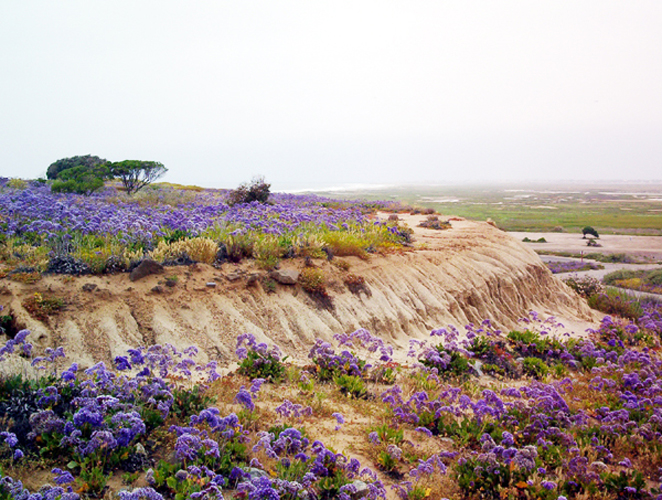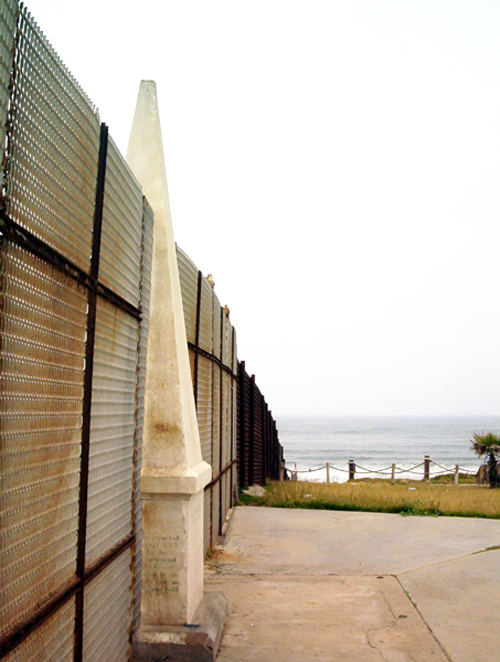 |
Coastal Commission Rejects Extension
|

Endless fields of purple statice grow amid varied grasses, the marsh stretches out to the Pacific. |

Endless fields of purple statice grow amid varied grasses, the marsh stretches out to the Pacific. |
On February 18, 2004 the California Coastal Commission unanimously found that the plan by the U.S. Bureau of Customs and Border Protection (CBP) to complete the final 3.5 miles of a triple-fenced security zone at the U.S.-Mexico border is inconsistent with the federal Coastal Zone Management Act. The final 3.5 miles run from just west of the international Wastewater Treatment Plant to the Pacific Ocean, and include the Border Highland area and Border Field State Park. The 10-member commission and staff found that extension of the triple-fenced security zone into this area would be environmentally damaging.
The commission took exception to the Border Patrol's plan to create a 165-foot-tall, half-mile-long earthen bridge across Smuggler's Gulch, a deep canyon east of Border Field. This cut-and-fill operation would involve moving 2 million cubic yards of soil from the adjacent landscape. The commission was also concerned that erosion of the denuded border zone and earthen bridge could harm the federally protected Tijuana River National Estuary. The U.S. Fish and Wildlife Service also opposed this massive fill.
Border Patrol officials insisted that the triple-fence zone is needed to deter illegal border crossings and to protect its agents. This zone would consist of a new 14-foot-tall perforated steel fence about 130 feet north of the existing fence. The new fence would tilt at the top to deter climbers. High-speed patrol roads would be paved on both sides of this second fence. The third fence of 8-foot high chain-link would be built north of the second fence to keep the public out and to keep the Border Field agents from driving off sheer slopes. Included in this zone would be lights, sensors, cameras, and related infrastructure.
Republican Congressman Duncan Hunter has pushed for this project for more than a decade. He said that this project is needed to deter drug smugglers, reduce illegal immigration, and prevent terrorists from reaching San Diego's defense facilities. An aerial photo of the border area that he displayed showed many trails that he said were caused by illegal immigrants. He said that it would take up to a hundred years for nature to restore itself in the area. Hunter opined that the triple-fence project would actually protect the environment by preventing these trails from being created across the border.
A number of people from environmental and preservation groups spoke in opposition to this project. Save Our Heritage Organisation (SOHO) placed Border Field State Park on its Most Endangered list in 2002. SOHO is concerned that the triple-fence project would endanger the entire cultural and environmental landscape at this international setting. It could also harm numerous 7,000-year-old archaeological sites in the area.
William Doyle, representing SOHO before the commission, said "This triple-fence project would denude a swath of vegetation about the width of a six-lane freeway. It would cut across a habitat preserve included in the Multiple Species Conservation Program, a system of interconnected open-space areas established by the federal and state governments. The project would also endanger the Tijuana River Estuary, one of the few salt marshes remaining in Southern California. This estuary is an essential breeding, feeding, nesting ground, and stopover point for over 370 species of migratory and native birds, including six endangered species. Another area of concern is the historic Boundary Marker Number 258 (originally the first border marker). It was made from Italian marble, shipped around Cape Horn in pieces, and placed on site on June 16, 1851 to mark the boundary between the United States and Mexico. In 1971 First Lady Pat Nixon dedicated 396 acres around this monument as Friendship Park. (After the tree planting ceremony and formal presentation, Mrs. Nixon ordered a section of the border fence cut, and she greeted, embraced, and kissed Mexican children who had been clamoring for her attention. "I hope there won't be a fence here too long", she said.) The placement of the triple-fence could further jeopardize the public's access to and enjoyment of this historic landmark."
SOHO member María Castillo-Curry also spoke before the commission about her concern that this project would negatively impact the inhabitants of Playas de Tijuana and would be an obstacle to friendship in this international area.
Speaking to reporters, Duncan Hunter said that a rejection by the commission would be "nutty" and that he would work vigorously to overturn it. On March 1, 2004, Hunter requested a federal waiver to override the Coastal Commission's decision. He said, "Since the Coastal Commission is denying our right to build the fence, we are asking the Bush administration to issue a waiver that will allow us to build it."
Coastal Commission Chairman Mike Reilly said, "This is not a surprise, and certainly Congressman Hunter has invested in that project for a number of years. It's his baby, but we're more interested in hearing from the Border Patrol." (Chairman Reilly is interested in knowing whether the Border Patrol wants to reconsider its rejection of the Coastal Commission's staff recommendations and thereby avoid destruction of a multimillion-dollar habitat preserve).
Asa Hutchinson, the undersecretary for Border Transportation Security in the Department of Homeland Security, said the triple-fence project is needed to improve border security and discourage illegal immigration. "It does need to be completed," she said during a news conference at North Island Naval Air Station. The Department of Homeland Security could ignore the ruling, which could force the commission to try to halt the project by obtaining an injunction in federal court.
Commissioner John S. Woolley welcomed the fight and said, "For those individuals who wish to pursue this in other venues I wish them Godspeed. That's what this nation needs to press so we don't run amuck with the kind of laws the Homeland Security Act may provide."
President Bush could ultimately override any such injunction on grounds of national security. He could also issue a federal waiver to override the Coastal Commission's rejection of the triple fence at the border.
Call For Action
Write to Governor Arnold Schwarzenegger and ask him to support the California Coastal Commission's decision to protect our coast from the border triple-fence extension project.
Write to President George W. Bush and let him know that a triple fence into Border Field State Park would damage the environment and the spirit of friendship between the United States and Mexico. If anything, he should re-dedicate this area as an International Friendship Park.
Contacting the Governor
Governor Arnold Schwarzenegger
State Capitol Building
Sacramento, CA 95814
Phone: 916-445-2841
Fax: 916-445-4633
governor@governor.ca.gov
Contacting the White House
The White House
1600 Pennsylvania Avenue NW
Washington DC 20500
Phone Numbers
Visitors Office: 202-456-2121
Comments: 202-456-1111
Switchboard: 202-456-1414
Fax: 202-456-2461
TTY/TDD
Comments: 202-456-6213
Emails
President George W. Bush: president@whitehouse.gov
Vice President Richard Cheney: vice.president@whitehouse.gov
Quotes in the above article appeared on SignOnSanDiego.com in articles written by Seth Hettena/Associated Press, Terry Rodgers/Union-Tribune, Marisa Taylor/Union-Tribune, and Janine Zuniga/Staff Writer.
2004 - Volume 35, Issue 2
MORE FROM THIS ISSUE
Grants & Donations to the Whaley House
Volunteer Today at the Whaley House
INCENTIVES! Cliffs Notes for Tax Credits
Join Us for the James Hubbell Homes Tour
SOHO Home Tours
Free "Arch in the Park" Family Event
A Search for San Diego Courtyards
The Repair of Historic Wooden Windows
DOWNLOAD full magazine as pdf (4.9mb)
Mailing - PO Box 80788 · San Diego CA 92138 | Offices - 3525 Seventh Avenue · San Diego CA 92103
|


